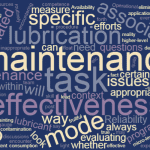
Who knew that Stonehenge could teach us about achieving our equipment Reliability goals? Watch as I describe how Stonehenge has changed, because the same thing may be happening with your equipment… [Read more…]
Your Reliability Engineering Professional Development Site
Find all articles across all article series listed in reverse chronological order.
by Nancy Regan Leave a Comment

Who knew that Stonehenge could teach us about achieving our equipment Reliability goals? Watch as I describe how Stonehenge has changed, because the same thing may be happening with your equipment… [Read more…]
by Perry Parendo Leave a Comment

Some will argue that chemical mixtures must use the dependent mixture matrices at all times. Others suggest that a factorial approach using ratios can accomplish the same objective with more flexibility. I have had success with the factorial approach in several situations, with several technologies. [Read more…]
by Fred Schenkelberg Leave a Comment

I have found the best way to lose an audience is to focus on statistical derivation. While this is a fascinating subject for me, it just doesn’t seem to hold an audience’s attention.
Having something interesting and useful to say is key to maintaining an audience’s attention, yet at times how we present helps them become distracted.
So, given great content or proposal, how can you help your audience not quickly check their phone, yet again? [Read more…]

I am a firm believer in the notion of doing everything with the end-goal in mind. That is the only way we can gauge the effectiveness of our efforts. The same is true for all our efforts related to Maintenance & Reliability.
If & when you want to measure a certain maintenance task for its effectiveness (you should be doing it quite often); the best way is to identify whether the desired outcomes associated with that specific task are being realized or not. [Read more…]
by Greg Hutchins Leave a Comment

I just got off the golf course hitting 9-holes with my Pop, who is 84 years old. God bless him, I hope he has many more rounds to play and I look forward to getting out as often as I can with him. We played the En-Joie Golf Club; a stop on the PGA Tour from 1972 to 2005 when the BC Open was played there – and now, as the Dick’s Sporting Goods Open, which is a stop on the Champions Tour.
It is unique in that the course is owned and operated by Broome County. This means that anyone off the street can play a PGA course for municipal rates, which top-out at $49 for 18-holes with a cart on summer weekends (it can be less, depending on date, day of the week, and time). [Read more…]
by Nancy Regan Leave a Comment

Who knew that a herd of cattle in Hartley Wintney, England could teach us something about equipment maintenance? Watch as I “graze” over the topic of manufacturer recommended maintenance tasks. (I hope you are “mooved” to take action!) [Read more…]
by Robert Kalwarowsky Leave a Comment

The golden rule for lubricant storage is keeping the lubricant “clean, cool and dry”. Let’s discuss 3 ways to improve your lubricant storage.
What are some best practices for lubricant storage at your plant?
[Read more…]
by George Williams Leave a Comment

We review the purpose of and how to use the Notification or Service Request applications of your CMMS [Read more…]
by Perry Parendo Leave a Comment

In Experimental Design, users will at times suggest use of a 2×2 matrix. This is not a practical approach for all but the rarest of occasions. Worse yet, some will teach the 2×2 matrix because it is simple. This misleads users that it is a reasonable option. This video explains the reasons why this design should never be used during phase 1 testing. [Read more…]
by Carl S. Carlson Leave a Comment

“However beautiful the strategy, you should occasionally look at the results.”
Winston Churchill
The Oxford English dictionary defines “strategy” as “a plan of action or policy designed to achieve a major or overall aim.”
Reference the article Understanding FMEA Severity Risk – Part 1 which discusses how Severity is defined and applied in FMEA.
by Greg Hutchins Leave a Comment

In project management we can’t always be in control of the environment around us. We can only forecast rather than predict risk and despite our ‘reasonable’ or even ‘best’ efforts to mitigate risk; shit happens and emergencies ensue! It’s not just physical emergencies but also those related to time and cost; overbudget or late projects can create an emergency for stakeholders. Perhaps it’s because we tend to look at the ‘big risks’ or the ‘top ten’ after some semiquantitative assessment but then fail to consider that risks can change with time as more information becomes available. Or, maybe it is because only those risks that can be clearly defined and are ‘likely’ are communicated to the eyes and ears on the ground. Those low probability, high impact risks can tend to slip under any risk radar.
Then there is the matter of ‘optimism bias’ and a belief that ‘nothing can go wrong’ or that ‘risk only happens to other people’. Or perhaps, it’s just a matter of management not appreciating what is going on and ‘taking their eye off the ball’. [Read more…]
by Robert Kalwarowsky Leave a Comment

A few weeks ago, I wrote about my thought processes for choosing an oil sampling location. To continue on the lubrication theme, I wanted to give you a few ideas for contamination control. Next week, I’ll take on lubricant storage. [Read more…]
by George Williams Leave a Comment

CMMS Work Order Priorities explained. [Read more…]
by Nancy Regan Leave a Comment

Watch how I made the same mistake with my shoes…and how I could have used RCM to help me! [Read more…]
by Perry Parendo Leave a Comment

When using tools such as DOE and Monte Carlo analysis, it is important to understand the capabilities of the input variables. This can lead to robust design. However, many do not ask the right questions and are surprised with less than desired performance. [Read more…]